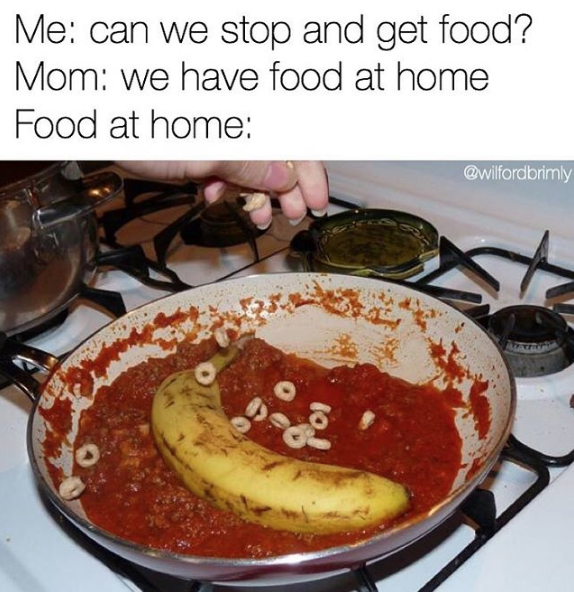Insights
Memescape: Enabler Formats
There are memes that take a lot of effort to make, that take honed photo and video editing skills, voice acting abilities, software in order to create convincing deepfakes. On the other hand, there are also memes that litte effort by comparison, simply slapping a stock caption on an image. We refer to these memes as "enabler" formats.



You've probably seen this type of meme in the wild. Enabler memes seemingly exist for the sole purpose of enabling you to reuse a cursed image you once saw and get away with thousands of internet points in your pocket. Some of these memes may feel so low-effort that it seems the poster would have been better off just uploading the image without adding a caption at all, but in the world of shitposting, there is often more than meets the eye.
One of the oldest and best-known offenders are the infamous "Nobody:" posts. To many, the image macro format wore out its welcome rather quickly, being seen as lazy and repetitive. It's clear that making a "Nobody:" tweet took little effort, but to simply write it off as such ignores recognizing this meme's enabler characteristics.
Rather than a proper meme format, "Nobody:" and it's variations, such as "Literally Noone:" and "Me:," were a simple setup for observational jokes.


The problem with observational comedy is that it requires a set up to hint that a joke is being made — otherwise it would be, well, just a statement. Imagine a stand-up performance: the comedian greets the audience and starts talking about some funny anecdotes, narrating them and making timely pauses when the audience is most likely to laugh. Now, imagine trying to fit both the set up and the joke into your 280 character tweet.
With "Nobody:," you were able to do just that. By writing a single word, people could easily signal to their audience that they were making an observational joke, ensuring viewers that what followed should be taken an attempt at humor. The overwhelming popularity of "Nobody:" memes resulted in a positive feedback loop: the more people saw "Nobody:" tweets and posts, the more came to understand "Nobody:" as a signal of comedy. This, however, did not mean that everybody "got" it. But "getting it" wasn't even all that necessary.


"Nobody:" wasn't a "good" meme format in a traditional sense — it wasn't high-effort, or required creativity and innovation. Many "Nobody:" memes were simple written jokes. In many examples, the "Nobody:" lead wasn't even required, adding little to many of the posts using it. Regardless, people used the framing endlessly, fearing that their meme wouldn't be quite good enough without it.

Essentially, "Nobody:" managed to become a successful mainstream format that made memeing easier than it has ever been.
Similar to how "Nobody:" invited in observational humor into the meta, "Don't Leave Me" TikTok trend repurposed puns and dad jokes by adding a seemingly unnecessary punchline.
https://www.tiktok.com/embed/v2/6834234095791312133
https://www.tiktok.com/embed/v2/6837996223132110085
https://www.tiktok.com/embed/v2/6839052535483878662
This short-lived format took puns that just wouldn't fly on their own and made them shine by adding a surreal punchline of a person going crazy for the joke and running after the one who made it. And just as "Nobody:," the format did not see any flexibility, as it was only used to turn simple puns into memes. Twitter users liked it so much that they repurposed the concept with SpongeBob 'Call That X' Puns.



Some "enabler" formats function in a slightly different way. Instead of providing a signal for viewers to recognize a certain type of joke, they serve as an excuse to post a funny or "cursed" image.
There are a lot of these formats, each one fine-tuned for posting a certain type of image. For example, the phrase "Bowling Alley Screen When You Get a Strike" format is the way to go when a funny 3D render is gathering dust in one's meme folder. Got an image of a funny-looking bed? Post a "We Fuckin on the X Bed" meme. With the What If We Kissed In format, a picture of nearly any place on Earth with a modicum of cultural significance could be a meme.



Just like "Nobody:" and "Don't Leave Me," these formats also had a defined purpose: squeezing leftover likes from funny or "cursed" images that have already widely circulated online by pairing them with a fitting caption. The image would typically come first, and the caption would just be added as an excuse to post it.



Finally, there is one "enabler" format that deserves a special mention for its sheer bluntness. Barnacle Boy's Sulfur Vision simply holds back no punches: it is an meme that can memefy anything you want, as long as at least some people recognize what you are showing them.



While the "enablers" fail to compete with more advanced formats in terms of the skill, expertise, creativity and flexibility involved, they serve a purpose within the internet culture meta that is difficult to overlook. Enhancing the comedic potential of jokes that just don't have what it takes on their own, "enabler" formats can bring in types of humor that are hard to use independently and reintroduce old images into the meta. Considering how easy they are to make — having a Twitter account is generally enough to create one — the "enablers" won't be leaving the memescape any sooner than we run out of images that need just a little push to become memes.

Comments ( 0 )
Sorry, but you must activate your account to post a comment.
Please check your email for your activation code.